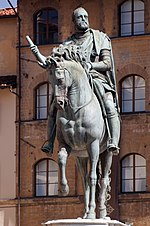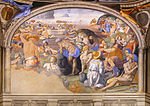Palazzo Vecchio

The Palazzo Vecchio (Italian pronunciation: [paˈlattso ˈvɛkkjo] "Old Palace") is the town hall of Florence, Italy. It overlooks the Piazza della Signoria, which holds a copy of Michelangelo's David statue, and the gallery of statues in the adjacent Loggia dei Lanzi. Originally called the Palazzo della Signoria, after the Signoria of Florence, the ruling body of the Republic of Florence, this building was also known by several other names: Palazzo del Popolo, Palazzo dei Priori, and Palazzo Ducale, in accordance with the varying use of the palace during its long history. The building acquired its current name when the Medici duke's residence was moved across the Arno River to the Palazzo Pitti.
Excerpt from the Wikipedia article Palazzo Vecchio (License: CC BY-SA 3.0, Authors, Images).Palazzo Vecchio
Via della Ninna, Florence Quartiere 1
Geographical coordinates (GPS) Address External links Nearby Places Show on map
Geographical coordinates (GPS)
| Latitude | Longitude |
|---|---|
| N 43.769444444444 ° | E 11.256111111111 ° |
Address
Palazzo Vecchio
Via della Ninna
50122 Florence, Quartiere 1
Tuscany, Italy
Open on Google Maps











